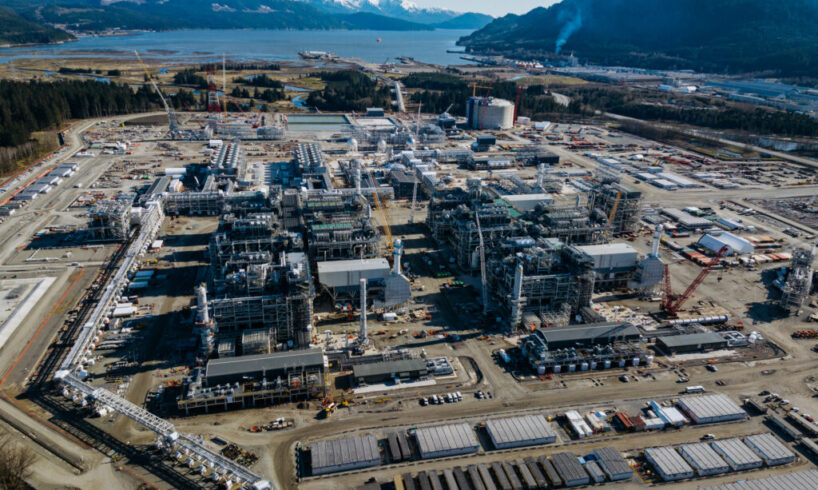
Flames as high as a 30-storey building, ships nearly as long as the Eiffel Tower is tall, $40 billion dollars. Everything about LNG Canada is big — including its promises.
Often referred to as the largest private investment in Canadian history, the megaproject connects B.C. shale gas reserves near the Alberta border to marine shipping routes on the northwest coast. More than a decade after the project was first approved, Canada’s liquefied natural gas (LNG) sector is finally up and running: LNG Canada sent its first shipment to Asia on June 30.
As exports start flowing overseas from the Kitimat, B.C., facility, two more liquefaction plants are under construction — Woodfibre LNG and Cedar LNG. Another, Ksi Lisims LNG, could be approved any day. The promise around all this industrial buildout has always been prosperity, but whether the industry can deliver, and for how long, is up for debate.
LNG Canada is now operating its first phase, which will produce up to 14 million tonnes of supercooled gas per year. It’s already approved and permitted to double production. Photo: Marty Clemens / The Narwhal
“An oversupply of LNG is widely expected, potentially starting as early as next year, with a massive wave of new projects coming online around the world, especially in the U.S. and Qatar,” Steven Haig, a policy advisor with the International Institute for Sustainable Development, told The Narwhal. “When it comes to the economic benefits of LNG, Canada is really late to the party — and that party is almost over.”
Haig and his colleagues recently penned a deep dive into the risks of locking in more LNG infrastructure, reporting that Canadian exports are unlikely to achieve “energy security for importers or economic resilience for exporters.”
“What we explain in our analysis is that we are very likely moving into a period of oversupply with lower prices — and those lower prices may well be below what projects need to break even,” Haig told The Narwhal. “If they run at a loss for too long, then they can become stranded assets, with economic implications for the people who work for these facilities or for communities that might become economically associated with them.”
‘Higher domestic prices for Canadian consumers’ are a possibility
As Canadian LNG — the liquid form of natural gas, which is mostly composed of methane and in B.C. is extracted primarily through fracking — starts making its way into international markets, British Columbians and Albertans could also see a spike in their heating bills, according to Deloitte Canada. As the Financial Post recently reported, domestic natural gas prices could jump up by 60 per cent this year, and climb even higher next year.
Haig said if the price a company can get from exporting LNG is higher than it can get selling natural gas domestically, prices in places like B.C. and Alberta will go up. This happened in Australia, where domestic prices tripled as Russia’s 2022 invasion of Ukraine sent shockwaves through the supply chain.
“LNG links regional gas markets together in the global LNG market,” Haig explained. “So a local supply disruption in one place can lead to skyrocketing LNG prices elsewhere.”
“When those high prices are in effect, then it can become more profitable for a gas producer in Canada, for example, to export that gas to the international LNG market than to use that gas in Canada’s domestic gas market.” That, he said, can lead to higher domestic prices for Canadian consumers.
LNG Canada is now operating its first phase, which will produce up to 14 million tonnes of supercooled gas per year. It’s already approved and permitted to double production.
Teresa Waddington, LNG Canada’s vice-president of corporate relations, told The Narwhal earlier this month that talks are underway about whether or not to go ahead with the expansion. She said a final decision depends on a number of factors including “overall competitiveness [and] affordability.” LNG Canada did not respond to new questions from The Narwhal by publication time.
When the international consortium of oil and gas companies behind LNG Canada (Shell, Petronas, Korea Gas, PetroChina and Mitsubishi) first started courting Canada to develop an LNG export industry in B.C. in the early 2010s, they said it would boost the economy locally, provincially and federally. With recent trade threats from the U.S. government, that narrative is gaining traction again and politicians like B.C. Premier David Eby and Prime Minister Mark Carney are celebrating the sector as an economic saviour.
Haig cautioned the narrative should be taken with a grain of salt.
“We’re seeing this big push towards LNG expansion to diversify Canada’s exports beyond the United States, but these are multi-billion dollar and multi-decade projects,” he explained. “Their long-term viability is a serious concern as global markets shift towards cleaner and more reliable energy sources, like renewables. Investing in LNG as a supposed transition fuel in the meantime would be a long, costly detour.”
‘It’s not too late’: Canada can reduce economic and climate risks by putting the brakes on LNG exports, expert says
Alongside promises of prosperity, LNG Canada and other proponents of the sector maintain the gas is a so-called “bridge” or transition fuel — a climate solution. The argument goes like this: burning gas to generate power is less harmful than burning coal, and B.C. exports will help countries like China substantially reduce their reliance on the “dirtier” fossil fuel. The first part is the subject of much debate, especially when the entire lifecycle of LNG is taken into consideration. The second — that Canadian LNG will displace coal — Haig said simply isn’t true.
“Coal is cheap, renewables are cheap and LNG is not,” he said. “If we look at China’s power sector, for example, it’s renewables — not LNG imports — that are eating into coal’s market share. This is mostly because renewables are cheaper than LNG and because LNG requires expensive new infrastructure, such as re-gasification plants and pipelines, to connect consumers with supply.”
LNG Canada and other proponents of the sector often tout the industry as a climate solution. But a policy advisor with the International Institute for Sustainable Development told The Narwhal renewables are cheap and solar capacity is increasing by leaps and bounds in countries that are moving away from coal, like China. Photo: Leah Hennel / The Narwhal
China, while still responsible for about one third of the world’s greenhouse gas emissions, is outpacing the rest of the world by leaps and bounds in building renewables. In May this year, the country added the equivalent of 100 solar panels per second. As the Guardian reported in June, “China’s installed solar photovoltaic capacity has now surpassed 1,000 gigawatts for the first time, equivalent to half of the world’s total installed solar capacity.”
Haig said Canada is at a crossroads as it decides whether or not to approve more LNG projects, but added, “it’s not too late.”
“LNG exports can delay investments in renewables and generally increase global fossil fuel use, increasing global greenhouse gas emissions,” he said. “Doubling down on LNG projects would likely expose Canadians to more risk and volatility, not less.”





